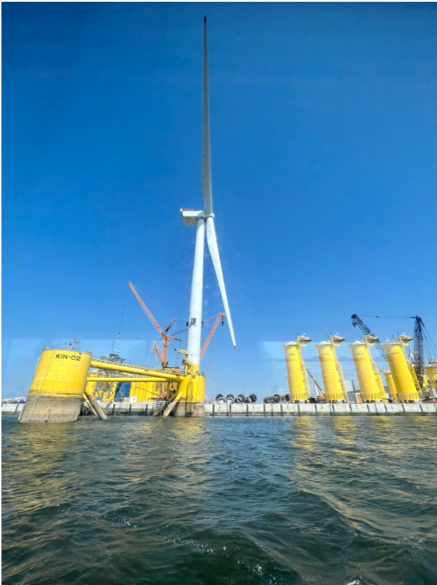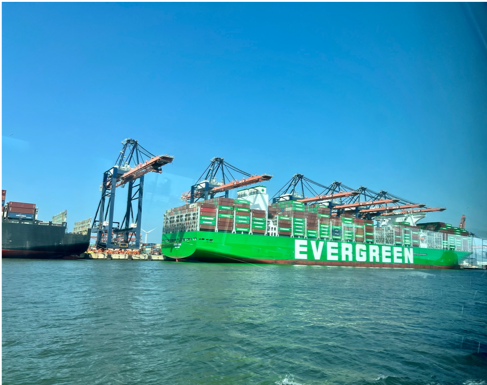The Energy Transition: Up Close at TNO labs and the Port of Rotterdam
June 28, 2023
The Burch Fellowship Students immersed themselves first-hand in the energy transition with two site visits today with TNO labs and the Port of Rotterdam. These site visits provided us with the tools and knowledge to advance in the future of the energy transition.
Departing early in the morning, the group embarked on the two-hour bus ride to TNO labs in Petten, Netherlands. On our way here, we were able to catch a glimpse of the wind turbines that extended along the coast and through the country of the Netherlands, providing immense renewable power to these local areas. Hidden in the rolling hills of Petten was TNO’s seaweed processing lab, which is the largest of its kind worldwide.
TNO provides innovative solutions to the world’s most pressing global climate challenges to achieve a healthy, safe, and sustainable society. With more than 22 locations researching various projects, we had the opportunity to visit their seaweed processing lab. This particular lab consists of test facilities that are utilized for innovative processing routes from seaweed to biofuels and green raw materials.
After arriving, we were courteously offered coffee and cookies to energize ourselves for our upcoming tour around the lab. During our visit, our tour guide described the test facilities in the technological development for the conversion of biomass into green energy biofuel sources and raw materials. These raw materials can produce basic materials for fuels, bioplastics, textiles, sweeteners, antioxidants, minerals, and more. We were presented with prospective products made entirely of seaweed, including wood building materials, to-go carton boxes, and even biodegradable feminine products. Touring the lab, we viewed all of the machines that were used to process the seaweed, including IKA laboratory equipment, which we had toured in Freiburg a week before. After we finished our extensive tour observing how seaweed is processed and utilized, we were offered lunch with their homemade sandwiches and juice and said our goodbyes.
After our insightful visit to TNO, we headed back towards Rotterdam and headed to our next site-visit at the Port of Rotterdam to see their expansion in Maasvlakte 2 sustainable port development. The future of sustainable port development comprises the world’s largest container ships, giant wind turbine foundation piles for new offshore wind farms assembled, solar farms, container transport, and the chemical industry including biochemicals made from waste.
First, we met with Maarten Van Oosten, the CIO, for the growth of Maasvlakte 2. Here he gave a presentation about the “smart” port they are developing. This development includes the port being expanded by man-made natural resources while increasing its wind turbine production around the entire island. Maarteen explained that to build the port out successfully, they must “construct with nature” and build a pyramid of sand and water. Furthermore, Europe’s largest green hydrogen plant will be built here, and Shell has made the final investment decision in this. The plant will be named Holland Hydrogen I and is expected to be operational in 2025 and will produce 60,000 kilograms of renewable hydrogen per day. The renewable power for the electrolyzer will come from the offshore wind farm Hollandse Kust (Noord), which Shell partly owns.
Marteen included the future of the energy transition with the development of a North Sea wind power hub consortium. This will consist of wind energy hubs in the North Sea, collaborating with the Netherlands, Germany, Denmark, Norway, and the United Kingdom. This is expected to produce 70-150 GW by 2040. Marteen also mentioned future possibility projects such as container drones, which are unmanned container ships.
After our presentation, we had the opportunity to board their boat, which took us around the Port, where we first hand saw the expansion of the island with the wind turbines, the future site of the hydrogen production, and their offshore wind turbine project.
First, we saw one of the world’s largest offshore wind turbines currently being tested onshore, named the Haliade-X. The wind turbine has enormous 107-meter-long blades, up 248 meters high, and has a 12MW capacity, sufficient to generate energy to supply electricity to some 16,000 households in the region. This turbine is ultimately intended for a location at sea but is still being tested out at the Port.
We saw the technological expansion of the cranes for the containers, which transitioned to new remote-controlled tech. This increases the safety and health of the crane operators, allowing them to control the “joystick” from the ground essentially. Furthermore, these robot cranes are all climate neutral and powered by the port’s wind turbines.
Pictured is Haliade-X being tested, however it was not generating any wind power as it needed maintenance.
With the port being the most significant and busiest in Europe, many ships were unloading and loading their cargo, in which we saw the robot cranes being utilized. One of the ships included in this was the Evergreen cargo ship, the fourth largest cargo ship in the world which can hold 24,000 containers.

Overall, we are seeing first-hand the future of the energy transition with not only renewable energy but the production of future biodegradable materials that can be encompassed in our everyday life. We must continue to pursue research and development for these projects. As the next generation, we will assume that our interactions with nature are vital to success. Gen Z has a moral obligation to each other, future generations, and other species to sustain our one planet; we must initiate actions to preserve our world and leave it a better place.
About the Author
This article was written by Sarah Rogers, ’25, Environmental Studies and Business on the UNC Burch Cleantech European trip.
